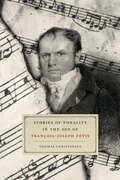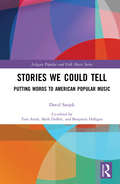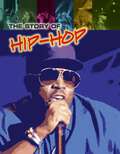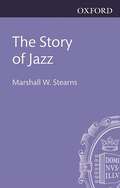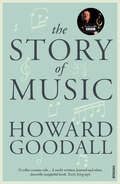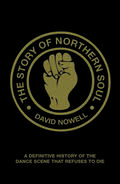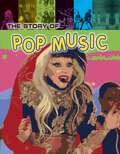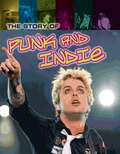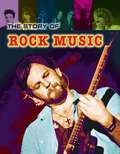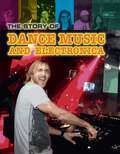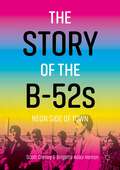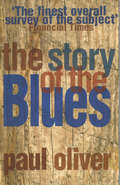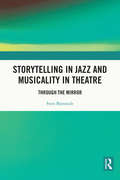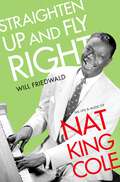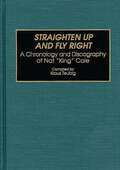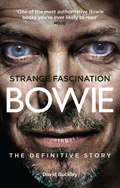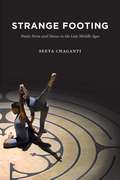- Table View
- List View
Stories of Tonality in the Age of François-Joseph Fétis
by Thomas ChristensenStories of Tonality in the Age of François-Joseph Fétis explores the concept of musical tonality through the writings of the Belgian musicologist François-Joseph Fétis (1784–1867), who was singularly responsible for theorizing and popularizing the term in the nineteenth century. Thomas Christensen weaves a rich story in which tonality emerges as a theoretical construct born of anxiety and alterity for Europeans during this time as they learned more about “other” musics and alternative tonal systems. Tonality became a central vortex in which French musicians thought—and argued—about a variety of musical repertoires, be they contemporary European musics of the stage, concert hall, or church, folk songs from the provinces, microtonal scale systems of Arabic and Indian music, or the medieval and Renaissance music whose notational traces were just beginning to be deciphered by scholars. Fétis’s influential writings offer insight into how tonality ingrained itself within nineteenth-century music discourse, and why it has continued to resonate with uncanny prescience throughout the musical upheavals of the twentieth and twenty-first centuries.
Stories of Tonality in the Age of François-Joseph Fétis
by Thomas ChristensenStories of Tonality in the Age of François-Joseph Fétis explores the concept of musical tonality through the writings of the Belgian musicologist François-Joseph Fétis (1784–1867), who was singularly responsible for theorizing and popularizing the term in the nineteenth century. Thomas Christensen weaves a rich story in which tonality emerges as a theoretical construct born of anxiety and alterity for Europeans during this time as they learned more about “other” musics and alternative tonal systems. Tonality became a central vortex in which French musicians thought—and argued—about a variety of musical repertoires, be they contemporary European musics of the stage, concert hall, or church, folk songs from the provinces, microtonal scale systems of Arabic and Indian music, or the medieval and Renaissance music whose notational traces were just beginning to be deciphered by scholars. Fétis’s influential writings offer insight into how tonality ingrained itself within nineteenth-century music discourse, and why it has continued to resonate with uncanny prescience throughout the musical upheavals of the twentieth and twenty-first centuries.
Stories of Tonality in the Age of François-Joseph Fétis
by Thomas ChristensenStories of Tonality in the Age of François-Joseph Fétis explores the concept of musical tonality through the writings of the Belgian musicologist François-Joseph Fétis (1784–1867), who was singularly responsible for theorizing and popularizing the term in the nineteenth century. Thomas Christensen weaves a rich story in which tonality emerges as a theoretical construct born of anxiety and alterity for Europeans during this time as they learned more about “other” musics and alternative tonal systems. Tonality became a central vortex in which French musicians thought—and argued—about a variety of musical repertoires, be they contemporary European musics of the stage, concert hall, or church, folk songs from the provinces, microtonal scale systems of Arabic and Indian music, or the medieval and Renaissance music whose notational traces were just beginning to be deciphered by scholars. Fétis’s influential writings offer insight into how tonality ingrained itself within nineteenth-century music discourse, and why it has continued to resonate with uncanny prescience throughout the musical upheavals of the twentieth and twenty-first centuries.
Stories We Could Tell: Putting Words To American Popular Music (Ashgate Popular and Folk Music Series)
by David SanjekHow has the history of rock ‘n’ roll been told? Has it become formulaic? Or remained, like the music itself, open to outside influences? Who have been the genre’s primary historians? What common frameworks or sets of assumptions have music history narratives shared? And, most importantly, what is the cost of failing to question such assumptions? "Stories We Could Tell:Putting Words to American Popular Music" identifies eight typical strategies used when critics and historians write about American popular music, and subjects each to forensic analysis. This posthumous book is a unique work of cultural historiography that analyses, catalogues, and contextualizes music writing in order to afford the reader new perspectives on the field of cultural production, and offer new ways of thinking about, and writing about, popular music.
Stories We Could Tell: Putting Words To American Popular Music (Ashgate Popular and Folk Music Series)
by David SanjekHow has the history of rock ‘n’ roll been told? Has it become formulaic? Or remained, like the music itself, open to outside influences? Who have been the genre’s primary historians? What common frameworks or sets of assumptions have music history narratives shared? And, most importantly, what is the cost of failing to question such assumptions? "Stories We Could Tell:Putting Words to American Popular Music" identifies eight typical strategies used when critics and historians write about American popular music, and subjects each to forensic analysis. This posthumous book is a unique work of cultural historiography that analyses, catalogues, and contextualizes music writing in order to afford the reader new perspectives on the field of cultural production, and offer new ways of thinking about, and writing about, popular music.
The Story of Hip Hop (Pop Histories)
by Matt AnnissTake a journey through the hard-hitting history of hip-hop music. Witness DJ Kool Herc's first block parties and the origins of hip-house and scratching. See how cheap drum machines and talented turntablists changed music forever and meet some of the hip-hop scene's greatest stars. ABOUT THE SERIES: This heavily illustrated, magazine-style series tells the story of music from the 50s to the present day, featuring quotes from contemporary artists about their influences and inspirations.
The Story of Jazz
by Marshall W. StearnsThe effect of jazz upon American culture and the American character has been all-pervasive. This superlative history is the first and the most renowned systematic outline of the evolution of this unique American musical phenomenon. Stearns begins with the joining of the African Negro's musical heritage with European forms and the birth of jazz in New Orleans then follows its course through the era of swing and bop to the beginnings of rock in the 50s, vividly depicting the great innovators, and covering such technical elements as the music's form and structure.
The Story of Music: From Babylon To The Beatles: How Music Has Shaped Civilization
by Howard Goodall*** Accompanies BBC2's major new TV series and The Story of Music in 50 Pieces on Radio 3 *** In his dynamic tour through 40,000 years of music, from prehistoric instruments to modern-day pop, Howard Goodall leads us through the story of music as it happened, idea by idea, so that each musical innovation – harmony, notation, sung theatre, the orchestra, dance music, recording, broadcasting – strikes us with its original force. He focuses on what changed when and why, picking out the discoveries that revolutionised man-made sound and bringing to life musical visionaries from the little-known Pérotin to the colossus of Wagner. Along the way, he also gives refreshingly clear descriptions of what music is and how it works: what scales are all about, why some chords sound discordant and what all post-war pop songs have in common.
The Story of Northern Soul: A Definitive History Of The Dance Scene That Refuses To Die
by David NowellWhat began as an underground 60s Mod scene in unlicensed, no-frills clubs in the North West of England became a youth craze that has long surpassed all others. The Northern Soul scene has confounded its critics by surviving and growing into an adult dance phenomenon whose followers share a passion for the music of Black America unrivalled anywhere else in the world. The Story of Northern Soul takes the first ever in-depth look at the culture, the music, the artists and the people frequenting the all-night venues which are synonymous with the British Soul Scene. Packed with memorabilia and anecdotes from the Twisted Wheel in Manchester to the mighty Wigan Casino, The Story of Northern Soul is the definitive history of a dance scene that refuses to die.
The Story of Pop Music (Pop Histories)
by Matt AnnissTake a journey through the sensational history of pop music. Witness the early days of pop, and get the inside track on how managers created groups and shaped their world famous sounds. See how music television transformed the industry and meet pop's greatest stars.
The Story of Punk and Indie (Pop Histories)
by Matt AnnissTake a journey through the riotous history of punk and indie music. Experience the origins of post-punk, Britpop, indie-pop and alternative rock music. See how dance and grunge music made an impact and meet some of punk and indie's greatest stars. ABOUT THE SERIES: This heavily illustrated, magazine-style series tells the story of music from the 50s to the present day, featuring quotes from contemporary artists about their influences and inspirations.
The Story of Rock (Pop Histories)
by Matt AnnissTake a journey through the rip-roaring history of rock music. Find out about the origins of rock and roll, progressive, and heavy metal. See how indie and grunge music made an impact and meet some of rock's greatest stars. ABOUT THE SERIES: This heavily illustrated, magazine-style series tells the story of music from the 50s to the present day, featuring quotes from contemporary artists about their influences and inspirations.
The Story of Techno and Dance Music (Pop Histories)
by Matt AnnissTake a journey through the radical history of techno and dance music. Find out about the origins of house, techno, hardcore, and chill out music. Witness how the synthesizer changed the dance music world forever and meet the world's biggest superstar DJs. ABOUT THE SERIES: This heavily illustrated, magazine-style series tells the story of music from the 50s to the present day, featuring quotes from contemporary artists about their influences and inspirations.
The Story of the B-52s: Neon Side of Town
by Scott Creney Brigette Adair HerronThe Story of the B-52s: Neon Side of Town is the first critical history of one of the most legendary and influential bands in American popular music. Locating The B-52s in the intellectual climate of their hometown of Athens, GA and following the band from New York’s downtown scene in the early 1980s to their upcoming farewell tour, the book argues that The B-52s are much more significant political and musical influences on American society than their reputation as a silly party band suggests, and that their ongoing commitment to values including cooperation, mutual support, and using disruptive fun as a form of social change are an antidote to the neoliberalization sweeping both Athens and the rest of the Western world. For example, the book shows how the band synthesized influences from the modern artists displayed at the University of Georgia art museum, early queer activism on campus in the 1970s, and their experiences as queer people living through the AIDS crisis to create music that continues to be artistically and politically influential today. The authors are active members of the Athens, GA music scene, and the book includes original interviews with a range of number close to the band.
The Story Of The Blues: The Making of Black Music (New Updated Edition)
by Paul Oliver'This is not only Oliver's finest book on the blues, but is perhaps the finest overall survey of the subject that has yet been written. ' FINANCIAL TIMES The influence of the blues on popular mainstream music is immense. Its fascinating history reaches back to the end of the nineteenth century, its roots in the work songs of slavery, the ballads and country music of black Americans. Paul Oliver places singers like Blind Lemon Jefferson, Bessie Smith, Muddy Waters and Lightnin' Hopkins firmly in the context of their surroundings. He considers every facet of the Blues, its themes and subjects, the impact of recording, its-far-reaching legacy. This is not simply the history of a music but a reflection of the tumult with American society.
Storytelling in Jazz and Musicality in Theatre: Through the Mirror
by Sven BjerstedtArt forms tend to mirror themselves in each other. In order to understand literature and fine arts better, we often turn to music, speaking of the ‘tone’ in a book and of the ‘rhythm’ in a painting. In attempts to understand music better, we turn instead to the narrative arts, speaking of the ‘story’ of a musical piece. This book focuses on two examples of such conceptual mirror reflexivity: narrativity in jazz music and musicality in spoken theatre. These intermedial metaphors are shown to be significant to the practice and reflection of performing artists through their ability to mediate holistic views of what is considered to be of crucial importance in artistic practice, analysis, and education. This exploration opens up possibilities for new theoretical and practical insights with regard to how the borderland between temporal art forms can be conceptualized. The book will be of interest not only to scholars of music and theatre, but also to those who work in the fields of aesthetics, intermedial studies, cognitive linguistics, arts theory, communication theory, and cultural studies.
Storytelling in Jazz and Musicality in Theatre: Through the Mirror
by Sven BjerstedtArt forms tend to mirror themselves in each other. In order to understand literature and fine arts better, we often turn to music, speaking of the ‘tone’ in a book and of the ‘rhythm’ in a painting. In attempts to understand music better, we turn instead to the narrative arts, speaking of the ‘story’ of a musical piece. This book focuses on two examples of such conceptual mirror reflexivity: narrativity in jazz music and musicality in spoken theatre. These intermedial metaphors are shown to be significant to the practice and reflection of performing artists through their ability to mediate holistic views of what is considered to be of crucial importance in artistic practice, analysis, and education. This exploration opens up possibilities for new theoretical and practical insights with regard to how the borderland between temporal art forms can be conceptualized. The book will be of interest not only to scholars of music and theatre, but also to those who work in the fields of aesthetics, intermedial studies, cognitive linguistics, arts theory, communication theory, and cultural studies.
Stradivarius: Five Violins, One Cello and a Genius
by Toby FaberEveryone knows of the legendary quality and unbelievable price tag of a Stradivarius violin. In this, the first popular account of the Stradivari phenomena, Toby Faber explores the life and methods of this unsurpassed craftsman. Following the life of his instruments as they pass through the hands of many of the greatest musicians that have ever lived, we learn how and why they have become objects of such veneration and desire. It is a dramatic tale of grand artistry, fantastic music, shady dealers, forgery and science. 'Fascinating, accessible and enjoyable' - Tracy Chevalier 'A captivating book . . . An extraordinary accomplishment and a compelling read' - TE Cahart, author of The Piano Shop On The Left Bank 'An inspired idea for a book' - Telegraph 'Faber has found in the Strad a delightful leitmotif for an original comedie humaine' - Financial Times 'Faber pitches the story just right, neither patronising nor baffling the reader' - Times
Straight from the Heart: BONNIE TYLER'S LONG-AWAITED AUTOBIOGRAPHY
by Bonnie TylerYou know the name and you can't mistake the voice. Now you can read the incredible story of how a shy, music-loving teenager called Gaynor Hopkins morphed into legendary international superstar Bonnie Tyler and carved out an extraordinary career that is still going strong to this day.After five decades in the business - during which time she has recorded some of the most iconic songs of all time, travelled the world and performed for royalty and the Pope - Bonnie is sharing her fascinating journey for the first time. And she's not holding back. From her early days growing up in a tiny mining village in South Wales, to her career as a club singer that led to her accidental discovery by a talent scout, the Top of the Pops devotee had no idea she would one day grace the infamous illuminated stage alongside some of her biggest idols. Her rise to fame would sound like a fairy tale if it wasn't all true.Bonnie has always determinedly followed her own path, even when sceptical music execs told her she would fail. Her bravery led to her working with the legendary producer and songwriter Jim Steinman, going on to record the classic power ballads 'Total Eclipse of the Heart' and 'Holding Out for a Hero', as well as duetting with some of the best-known names in the business. She is undoubtedly one of the biggest vocal powerhouses of her generation, but her roots remain firmly in her beloved Wales. She is resolutely down to earth, funny and endlessly charming. Whether she's talking about the family she adores or sharing hilarious anecdotes from her many years in the spotlight, Bonnie never fails to entertain.Finally, we get to hear the amazing tale of a woman who has led the way for so many other female artists - and has had a bloody great time doing it. Bonnie's much-anticipated memoir is inspirational, moving and straight from the heart.
Straighten Up and Fly Right: The Life and Music of Nat King Cole (Cultural Biographies)
by Will FriedwaldOne of the most popular and memorable American musicians of the 20th century, Nat King Cole (1919-65) is remembered today as both a pianist and a singer, a feat rarely accomplished in the world of popular music. Now, in this complete life and times biography, author Will Friedwald offers a new take on this fascinating musician, framing him first as a bandleader and then as a star. In Cole's early phase, Friedwald explains, his primary task of keeping his trio going was just as much of a focus for him as his own playing and singing, always a collective or group performance. In the second act, Cole's collaborators were more likely to be arranger-conductors like Nelson Riddle and Gordon Jenkins, rather than his sidemen on bass and guitar. In the first act, his sidemen were equals, in the second phase, his collaborators were tasked exclusively with putting the focus on him, making him sound good, while being largely invisible themselves. Friedwald brings his full musical knowledge to bear in putting the man in the work, demonstrating how this duality appears over and over again in Cole's life and career: jazz vs. pop, solo vs. trio, piano vs. voice, wife number one (Nadine) vs. wife number two (Maria), the good songs vs. the less-than-good songs, the rhythm numbers vs. the ballads, the funny songs and novelties vs. the "serious" songs of love and loss, Cole as an advocate for the Great American Songbook vs. Cole the intrepid explorer of other options: world music, rhythm & blues, country & western. Cole was different from his contemporaries in other ways; for roughly ten years after the war, the majority of hitmakers on the pop charts were veterans of the big band experience, from Sinatra on down.
Straighten Up and Fly Right: The Life and Music of Nat King Cole (Cultural Biographies)
by Will FriedwaldOne of the most popular and memorable American musicians of the 20th century, Nat King Cole (1919-65) is remembered today as both a pianist and a singer, a feat rarely accomplished in the world of popular music. Now, in this complete life and times biography, author Will Friedwald offers a new take on this fascinating musician, framing him first as a bandleader and then as a star. In Cole's early phase, Friedwald explains, his primary task of keeping his trio going was just as much of a focus for him as his own playing and singing, always a collective or group performance. In the second act, Cole's collaborators were more likely to be arranger-conductors like Nelson Riddle and Gordon Jenkins, rather than his sidemen on bass and guitar. In the first act, his sidemen were equals, in the second phase, his collaborators were tasked exclusively with putting the focus on him, making him sound good, while being largely invisible themselves. Friedwald brings his full musical knowledge to bear in putting the man in the work, demonstrating how this duality appears over and over again in Cole's life and career: jazz vs. pop, solo vs. trio, piano vs. voice, wife number one (Nadine) vs. wife number two (Maria), the good songs vs. the less-than-good songs, the rhythm numbers vs. the ballads, the funny songs and novelties vs. the "serious" songs of love and loss, Cole as an advocate for the Great American Songbook vs. Cole the intrepid explorer of other options: world music, rhythm & blues, country & western. Cole was different from his contemporaries in other ways; for roughly ten years after the war, the majority of hitmakers on the pop charts were veterans of the big band experience, from Sinatra on down.
Straighten Up and Fly Right: A Chronology and Discography of Nat King Cole (Discographies: Association for Recorded Sound Collections Discographic Reference)
by Klaus TeubigThirty years of collecting and 15 years of research have resulted in this discography that features all known recordings, transcriptions, and films made by Cole until 1950, when his jazz style faded away, and a selection of his later jazz-related trio sides. It includes for the first time Cole's unknown 16 transcriptions of his Wild Root broadcasts. This volume documents the development of a gifted pianist into a ballad-singing star and leader of the most famous jazz trio of the 1940s. All routes and recording activities by Cole and his fellow musicians from 1936 to the 1950s are chronicled here.Nat King Cole is widely known as a singer of unforgettable fame, but that he was a true King of Jazz Piano in its heyday and the inventor of today's piano trios is almost forgotten. This discography gives all details of the King Cole Trio's activities, listing recording sessions, available broadcasts on discs, film soundtracks, and guest appearances by the trio or by Cole alone, on such shows as Jubilee, Command Performance, Supper Club, Mail Call, and Kraft Music Hall. A special listing is included of those occasions when Cole participated as unknown or unnamed pianist on radio transcriptions for singers like Anita Boyer, Anita O'Day, The Dreamers, The Barrie Sisters, Bonnie Lake, Rose Murphy, Maxine Johnson, and Juanelda Carter. In addition, the book includes the Cole Trio's engagement routes with exact dates if known, names of promoters, and much more. The biographical portion is a fascinating period piece of Jazz-age memorabilia.
Strange Fascination: David Bowie: The Definitive Story
by David BuckleyThe Sunday Times bestseller.David Bowie was arguably the most influential artist of his time, reinventing himself again and again, transforming music, style and art for over five decades. David Buckley's unique approach to unravelling the Bowie enigma, via interviews with many of the singer's closest associates, biography and academic analysis, makes this unrivalled biography a classic for Bowie fans old and new. This revised edition of Strange Fascination captures exclusive details about the tours, the making of the albums, the arguments, the split-ups, the music and, most importantly, the man himself. Also including exclusive photographic material, Strange Fascination is the most complete account of David Bowie and his impact on pop culture ever written.
Strange Footing: Poetic Form and Dance in the Late Middle Ages
by Seeta ChagantiFor premodern audiences, poetic form did not exist solely as meter, stanzas, or rhyme scheme. Rather, the form of a poem emerged as an experience, one generated when an audience immersed in a culture of dance encountered a poetic text. Exploring the complex relationship between medieval dance and medieval poetry, Strange Footing argues that the intersection of texts and dance produced an experience of poetic form based in disorientation, asymmetry, and even misstep. Medieval dance guided audiences to approach poetry not in terms of the body’s regular marking of time and space, but rather in the irregular and surprising forces of virtual motion around, ahead of, and behind the dancing body. Reading medieval poems through artworks, paintings, and sculptures depicting dance, Seeta Chaganti illuminates texts that have long eluded our full understanding, inviting us to inhabit their strange footings askew of conventional space and time. Strange Footing deploys the motion of dance to change how we read medieval poetry, generating a new theory of poetic form for medieval studies and beyond.
Strange Footing: Poetic Form and Dance in the Late Middle Ages
by Seeta ChagantiFor premodern audiences, poetic form did not exist solely as meter, stanzas, or rhyme scheme. Rather, the form of a poem emerged as an experience, one generated when an audience immersed in a culture of dance encountered a poetic text. Exploring the complex relationship between medieval dance and medieval poetry, Strange Footing argues that the intersection of texts and dance produced an experience of poetic form based in disorientation, asymmetry, and even misstep. Medieval dance guided audiences to approach poetry not in terms of the body’s regular marking of time and space, but rather in the irregular and surprising forces of virtual motion around, ahead of, and behind the dancing body. Reading medieval poems through artworks, paintings, and sculptures depicting dance, Seeta Chaganti illuminates texts that have long eluded our full understanding, inviting us to inhabit their strange footings askew of conventional space and time. Strange Footing deploys the motion of dance to change how we read medieval poetry, generating a new theory of poetic form for medieval studies and beyond.
